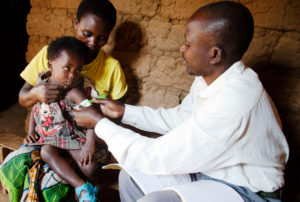 Prevailing social and gender norms are recognized as important determinants of individual health-seeking behavior throughout the three stages of service delivery. Norms have an impact on whether clients feel comfortable seeking services, seeking the necessary support to maintain required behaviors, or even discussing the service or health concern with anyone, including peers or the health provider. However, the relative importance of norms on individual behavior often depends on whether the individual thinks others are conforming to the norm and/or whether they believe others in society (friends, peers, family members, other influencers) expect them to adhere to the norm.
Prevailing social and gender norms are recognized as important determinants of individual health-seeking behavior throughout the three stages of service delivery. Norms have an impact on whether clients feel comfortable seeking services, seeking the necessary support to maintain required behaviors, or even discussing the service or health concern with anyone, including peers or the health provider. However, the relative importance of norms on individual behavior often depends on whether the individual thinks others are conforming to the norm and/or whether they believe others in society (friends, peers, family members, other influencers) expect them to adhere to the norm.
Norms are a specific set of beliefs, attitudes, and behaviors that are typical, acceptable, or even expected in a particular social context. Social norms are collectively agreed-upon standards and rules that most members of a group or society adhere to and accept. Gender norms are commonly accepted social or cultural rules that specify male and female characteristics, roles, acceptable behaviors, and capacities.
Social and gender norms can include a number of other rules or norms:
- Participation norms – Rules about who in a community or organization has power and can participate in decisions for the group. For some communities, participation norms allow only married adult men or elder women to make decisions about what community and/or health services are available; younger women and adolescents are not allowed to participate. These norms may also dictate whether a female client or youth is comfortable asking questions during a counseling session.
- Leadership norms– Community beliefs about what characteristics and responsibilities a leader should have and how leaders are chosen. These norms may determine whether an individual is considered credible and, therefore, a reliable source of information who can motivate others to adopt new behaviors.
- Norms about a specific issue or behavior – A community’s beliefs and rules about what is acceptable to discuss—who can participate on a specific issue, or whether a particular service is even appropriate. For example, when men who have sex with men and sex workers are seen as having “unacceptable” behaviors, they are often stigmatized and their health issues and required services are often taboo.
It’s important to understand which norm-related determinants present barriers or opportunities to inform service communication. For example, a social norm that restricts men’s involvement in reproductive health services may present a barrier for married women’s accessing family planning services. On the other hand, a cultural practice of male initiation ceremonies may create an opportunity for counseling and referrals to voluntary medical male circumcision services and clinical follow-up among young men at risk for HIV infection.
During the audience analysis, you identified information about each intended audience segment’s barriers to behavior. Before developing communication materials and strategies, it’s important to review the audience analysis to identify the existing barriers and determine whether they are related to environmental, skills/knowledge-based, or ideational determinants.
In doing so, consider the following questions:
- Does the audience face barriers to seeking health services related to prevailing social and gender norms? For example, is it acceptable for the primary audience (especially women or youth) to seek health services outside of the home or to pursue services without spousal or parental consent or financial support?
- Is it acceptable for the primary audience to speak openly with someone who is considered as having greater authority, better education, or a higher social class?
- Can services target a specific group or those whose behavior is deemed culturally unacceptable and therefore heavily stigmatized, such as sexually active youth, unmarried women, pregnant adolescents, sex workers, men who have sex with men, injecting drug users? Can these services be openly discussed and/or promoted? What confidentiality and security measures could avoid prevailing norms about stigmatized groups?
- Is the health area considered culturally taboo and not openly discussed?
- Are there existing hierarchies and rules of authority that dictate lower-quality treatment for the poor, uneducated, or those belonging to a certain ethnic group or social class?
- Is there a prevailing cultural belief that some modern medicine and/or clinical practices are unacceptable, imported from outside, or against tradition or religious beliefs?
The table below describes how various social and/or gender norms may be addressed using service communication.
| Issue | Before | During | After |
|---|---|---|---|
| Required parental/spousal consent is prohibitivee |
|
|
|
| Cultural norm prevents primary audience from speaking openly or freely with providers |
|
|
|
| Primary audience or behavior is stigmatized |
|
|
|
| Health area and/or service is considered taboo |
|
|
|
| Cultural beliefs reject some modern medical practices |
|
|
|
A number of tools are available for specifically identifying and prioritizing relevant gender norms. For more guidance on the steps to best identify and integrate gender into service communication, see the Integrating Gender into Social and Behavior Change Communication I-Kit.

